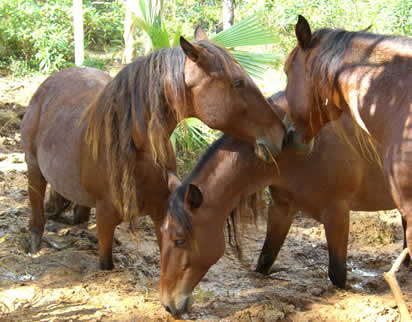 |
|
November 2006 Report
|
After the peace and quiet of the summer months, November has been a roller coaster.
Bahamas Hot Mix Nassau and Bahamas Hot Mix Abaco donated a D8 Bulldozer and driver for a day and a half of work. We now have access to three sides of the preserve (including the stallion area acreage).We can get men and equipment to a fire front and the road is wide enough to give us a fighting chance at stopping fires before they get into the Preserve. Fires have already been set in the area.
We have discovered that there is a Doppler sonogram unit available for overweight Moms to be that may work on our mares. We are hoping to raise funds for it.
We have received a negative (though they had to run the tests twice) report on the pregnancy testing of the mares' fecal samples taken last September. Since this is time dependent it may not have been entirely accurate.
We received an informal hair analysis from a veterinary group in Holland (a formal report has been requested) indicating that the mares are not pregnant and may have some hormonal imbalances.
Remember that Dr. Mautino suggested last August that no health tests be done because based on two years of monthly photographs the mares looked as though they could be pregnant. A second vet's opinion was that they could be pregnant. Further, the mares are now looking somewhat slimmer. If they were pregnant, this would be about the time when the fetuses are turning to align themselves along the lengths of the mares. In the wild this makes mares less attractive to predators and the foals would be aligned along the birth canal. There have been no signs whatsoever of mating (this has never happened before) and the stallion is well rounded out.
So we have some puzzles. To help solve them, we were fortunate to make the acquaintance of a company in California that has developed a simple urine sample test for pregnancy in horses. The company is not only sending us five tests gratis, they are willing to do bloodwork (if mares are not pregnant and can be tranquilized for the procedure of drawing blood) and they can make recommendations on hormone therapy if needed. This should give us a good indication of what is going on.
If in the future we do need to outcross and bring in new blood (or do artificial insemination or whichever procedure of several is indicated as appropriate) we have had an offer from a bona fide Barb breeder. We have asked for DNA work ups and we will send theirs and ours to our analyst at Texas A & M. The search continues for other possibilities. We are optimistic that if problems do exist they are not genetic but caused by the exposure to chemicals on the farm. After all, we lost one horse to damaged lungs, another damaged one is still with us, we lost a mare to what looked suspiciously like cancer. Yet, one mare died well into her 20's and though we haven't seen him in a while Hadar is well into his 20's. Both of these horses, because of their ages, spent the least amount of time on the farm.
In the good news department, Horse Illustrated magazine, with a readership of over 200,000, will be running an article on the Abaco Barbs in its February issue. We are also scheduled to appear in a German Horse magazine.
In the not so good news department, The Equus Survival Trust has declared the Abaco Barb the most rare and endangered breed of horse in the world. We hope that this frightening designation will alert more people to the fragile existence of these wonderful horses and will move them to help us save the breed. for a link to the text of the message, and to see a link to this year's very impressive young winner of the Abaco Barb Youth Project, please check the web site <http://www.arkwild.org>.
We hope you have wonderful holidays. Note that the horses remain blithly unaware of how very special they are. The mud keeps flies away from their legs.
|
 |
|
|